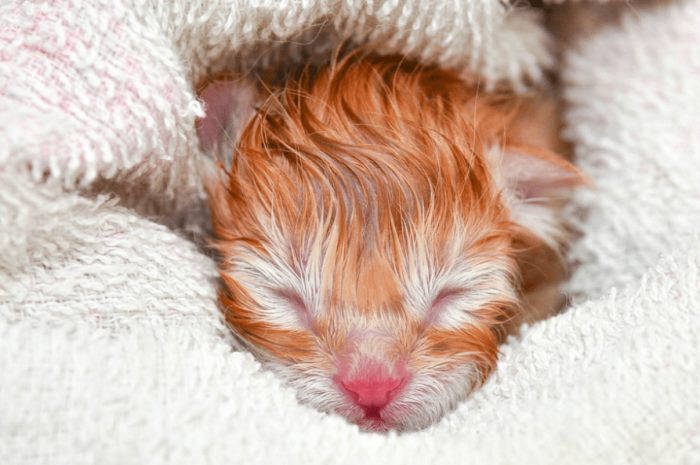The heating pad should be wrapped in a separate cloth, since newborn kittens naturally go to the bathroom under themselves. And under the heating pad, on top of a soft warm bedding like an old sweater, wool hat, etc., you need to put a separate rag, preferably on a plastic sheet, so that it can be changed if necessary. The following picture shows this nest arrangement. The kittens have always squirmed against the heating pad or slept directly on it.

- What to do if the cat abandoned the newborn kittens?
- 1) A sick kitten
- 2) A sick cat
- 3) Lack of milk
- 4) Stress
- How to take care of abandoned kittens?
- How to feed A newborn kitten
- How do I feed a kitten without a cat?
- Regular feeding
- Tummy massage combined with fur and eye care
- How often to feed.
- Calculation of the daily portion
- Hygiene procedures
- Warming pad for a newborn kitten
- Rules for nursing motherless kittens
- What newborn babies will need
- Feeding regimen
- Cat milk substitutes and kitten formula
- Baby formula for kittens
- Rules for feeding kittens without their mother
- What you will need
- Milk substitutes and formula
- Industrial cat milk substitutes
- How to feed newborn kittens
- Feeding frequency and weight gain
What to do if the cat abandoned the newborn kittens?
Usually the owners don't have to worry about newborn kittens – the cat takes care of them herself perfectly well. For the first two weeks she is almost always by their side and only goes away for a short time to eat or use the litter box. Nevertheless, sometimes the kittens are orphaned. The cat refuses to feed one or more of her cubs, or abandons all of them at once. This happens for a variety of reasons.
1) A sick kitten
It is natural for a cat to abandon weak kittens who have little chance of survival. From nature's point of view, they are not worth the energy and time it takes to raise offspring. In addition, if they are sick, they can infect the others. A cat cannot put them at risk.
Unfortunately, it is not uncommon for healthy kittens with physical disabilities to be "rejected". In this sense, cats are very picky, and even a small defect can be a verdict.
2) A sick cat
It is not uncommon for a cat to abandon kittens because she is not well. When she is in constant pain and has no energy at all, she is simply not able to take care of them.
With mastitis, the feeding process is so painful that the cat can't stand it. With milk fever, she becomes restless, drags the kittens from place to place or hides herself, doesn't pay attention to them or is aggressive. This is a severe nervous disease accompanied by loss of coordination or seizures. Without treatment, the animal may die.
3) Lack of milk
When a cat does not have enough milk for all the kittens born, she has to choose which to keep and which not to. She is usually unable to feed more than eight cubs. If she was malnourished during pregnancy, she may not have any milk at all. Sometimes this also happens after a cesarean section. In this case, the cat refuses the entire litter.
4) Stress
The nest with kittens should not become the object of close attention. If guests come in all the time and disturb the cat and pick up the kittens, she may walk away from them. Such a place does not seem safe to her, she is anxious all the time, unable to relax and take care of her offspring in peace. As long as no one is watching, the cat can move the kittens to a safer place. If there is no such opportunity, she abandons them. This is especially true for nervous, excitable animals.
How to take care of abandoned kittens?
If a cat firmly refused a particular kitten, you should not insist and constantly put it to her. It is possible that she will abandon the others. If she refuses all of them at once, you should take her to the doctor, perhaps there is a problem with her health.
What kittens that owners decide to self-feed need:
1) For the first 3 weeks, kittens need to be kept warm at all times. To do this, take a small box, lay it inside with a soft towel, a heating pad on it, and a cushion on top. The heating pad should not take up the whole area of the box, the kittens should have an opportunity to crawl away when they are too hot. It is important to arrange everything so they won't be able to touch the heating pad or crawl out of the box. It should be cleaned every day.
2) If the mother abandoned her kittens immediately after giving birth, you must give them colostrum, which appears in the cat's first day. It is necessary for their immunity.
3) Feed the kittens a special formula, not cow's milk. The schedule is approximately as follows: the first week – every 2-3 hours, starting from the second week – every 4 hours. The mixture should be heated, preferably in a water bath. It should be warmer than room temperature, but not hot. After feeding you should lightly massage the kitten's tummy.
In this way a cat gives up newborn kittens if they are sick or weak, if she is sick or if she does not have enough milk for all of them. Perhaps she does not feel safe. It can also be that she simply has no maternal instinct. But this does not mean that the babies are doomed to death. The cat can be helped if she needs help, or you can try to feed the kittens yourself.
How to feed
A newborn kitten
Ideally, kittens should remain close to their mother and be fed by her for up to eight weeks before they are separated and/or given to other owners. Human intervention is required if their birth mother needs to be rescued, if she dies, or in those circumstances where the cat refuses one or more kittens. If you need to nurse a newborn kitten, you have a lot to consider. Careful attention and proper preparation will turn artificial feeding of a kitten into a calming and comforting procedure that will result in a happy and healthy pet.
1. Try to find another nursing cat. Ask veterinarians and animal shelters if they know where you can find a nursing cat who can take in someone else's kitten. Mother's milk is the best food for any mammalian infant, so before trying to bottle feed a kitten with special formula, it is advisable to look for a foster nursing mother who can take the place of the absent or abandoned birth mother.
Always be present when the mother cat
Always be present when a foster cat interacts with a kitten; there is a risk that she will try to kill the kitten if she does not accept it. If luck is on your side and you find the mother, try to hide the real smell of the foster kitten. Try petting the feeder cat's native kittens and then pet the foster kitten. This will help give the other kitten's litter's native scent. A cat is more likely not to accept a kitten if it smells completely different, so by "getting rid" of the kitten's real scent, you increase the chances of it being accepted by the cat.
2. Get milk. A newborn kitten can only digest milk, and more specifically, cat milk. Feeding your kitten the wrong milk, such as cow's milk, can have its short-term and long-term consequences, including diarrhea, dehydration, nutritional deficiencies, and long-term health problems due to poor growth. You can purchase a cat milk substitute for your kitten, look for it at pet stores, veterinary clinics or online. In Russia you can find cat milk substitutes of the brands Royal Canin, Beaphar, Canina and others. For specific recommendations on the choice of specific and available for purchase in your area, you can consult a veterinarian.
How do I feed a kitten without a cat?
Hello! You can feed a kitten without a cat with special cat milk substitutes. Using cow's or goat's milk can be dangerous: the amount of lactose in them is much higher than in cat's milk, and the fat, protein and minerals are lower. This difference will not provide the body with the necessary nutrients for growth and development, and may also provoke a disturbance of the kitten's digestive system. Diarrhea can cause rapid dehydration, which in turn can lead to unpredictable consequences. Royal Canin has developed a special product – a cat milk substitute called Babycat Milk.
Feeding kittens should be strictly according to the instructions. In the first week of life, you need 7 feedings a day, in the second week – 6, in the third and fourth week – 5 feedings. After feeding, you should lightly massage the anal area with a soft cloth soaked in warm water to stimulate urination and defecation of the kitten.
Starting at four weeks of age, kitten food can be introduced. At first it should be soft so that the kitten can learn to lick the food (e.g. Royal Canin Mother & Babycat Kitten Mousse). On the first day, its amount should not exceed 10-20 grams. On each of the following days the amount of mousse should increase and the amount of milk replacer decrease. In this way, by week 5-6, the kitten will have completed the transition from milk replacer to a diet of denser consistency. Royal Canin Mother & Babycat dry and wet diets are adapted to kittens during the weaning period and will help to ensure harmonious growth and development, as well as supporting the sensitive digestive and immune systems.
Regular feeding
While the kittens were lying in the aforementioned basin, I found on the internet that you should feed orphans with a special cat milk substitute, sold in veterinary pharmacies. But cream of 10% will do, milk is usual high-fat, sometimes you need to add a raw egg yolk for 0.5 liters and 4 teaspoons of granulated sugar. Right away I went to the store.
As bottles adapted glass vials from under penicillin, and nipples we have become rubber parts of ordinary pharmacy pipettes. They easily stretched over the wide neck of the vials. But you need to buy 20 pipettes at once. They are then torn, then lost, then spoiled by the fast-growing teeth of kittens.
The milk needs to be heated, you can do it in the microwave for 3-5 seconds, check before feeding to see if it is too hot – basically, the same as for human babies. And, of course, you need to wash and dry the dropper "nipples" and vials after each feeding. It is convenient to pour the daily portion of milk into a separate jar with a polyethylene lid, store the jar in the refrigerator, stick a 10 ml syringe with a needle in the lid, which pours milk into the vial through the hole in the nipple. And you can use a syringe without a needle to draw milk from a can. It is more convenient than aiming milk from a tetrapack or can into a narrow penicillin bottle, then pulling the dropper over the filled bottle. The syringe and needle should also be washed regularly.
Portion volume of kitten grows from 10-20 ml of milk in the first week to 100 ml by 3-4 weeks, the frequency of feeding they set themselves. By two weeks, the penicillin bottle of 10 ml can be replaced with a vial of larger volume, for example, 20 ml of pharmaceutical vial from under the bacteriophage, and to weeks of three – at 100 ml bottle from under the alcohol, if the number of kittens more than one. Kittens eat depending on the weather – then every hour, then every 3-4 hours in sleepy, cloudy weather. When they are full, they lean away from the pacifier. Our kittens slept decently at night, letting me rest from midnight until about 8-10am for sure. Only the first night they kept me awake, eating every hour.
Tummy massage combined with fur and eye care
Normally a mother cat licks all the kittens' fur, eyes and mouth, thus not only cleaning them, but also massaging them. Massaging the tummy and crotch area is necessary for the kitten to relax and go to the toilet. Without massage, he does not know how to regulate his muscles.
Orphans can be massaged with a barely damp cloth, and their eyes can be wiped with damp absorbent cotton. The kitten itself will begin to wash at 20 – 25 days. Our kitten Moor (which we kept, and gave the second in a month and a half) began to wash from the eighth day, was captured on this day – for the story.
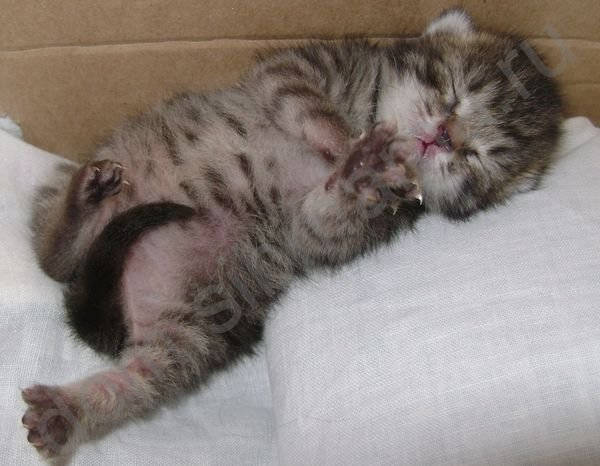
In the first 2-3 days the umbilical cord falls off, so the first few days the belly should be wiped particularly carefully. The procedure should be done after every time the kittens wake up, causing them to want to empty themselves. By 4 weeks, kittens can control the urge to go to the toilet, so at this age you can begin to accustom kittens to the litter box. We started even earlier, at 2 weeks, when the kittens just opened their eyes, so that the kittens would get used to the sight of the litter box, to the fact that the smell of the toilet should be located only in one limited place.
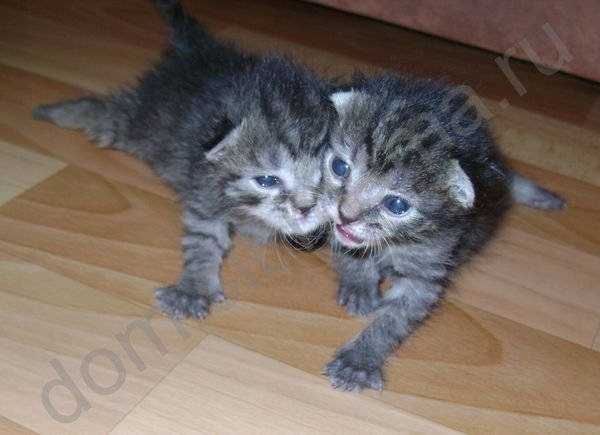
When we went to live in the country, we took the litter box with us. As soon as the kittens woke up, we carried them to the litter box and massaged their bellies and the crotch area, and they knew, that after sleeping they had to go to the bathroom, a pleasant feeling of relief of bladder and bowels was automatically remembered and associated with the litter box. This way we practically "led by hand" the kittens to the bathroom, so that by the age of a month and a half Moor began to go to the toilet by himself one day. A couple of days I watched him, no mistakes happened. Of course, then a couple of times there were lapses, but I washed everything with soap and put a lid with a few drops of vinegar, and that place Mavrik forgot.
How often to feed.
It is absolutely necessary to follow the regime and watch the portions of the mixture. For the first two weeks you will have to feed your kitten every 2 hours, even at night. Then the intervals are gradually reduced. After five weeks, the kitten can easily go 3-4 hours without food, and one feeding is enough at night.
At 6 weeks of age, kittens are eating on their own: they need to be fed up to 5 times a day and only during the daytime. Kittens grow very fast, so the feeding period will not seem very long.
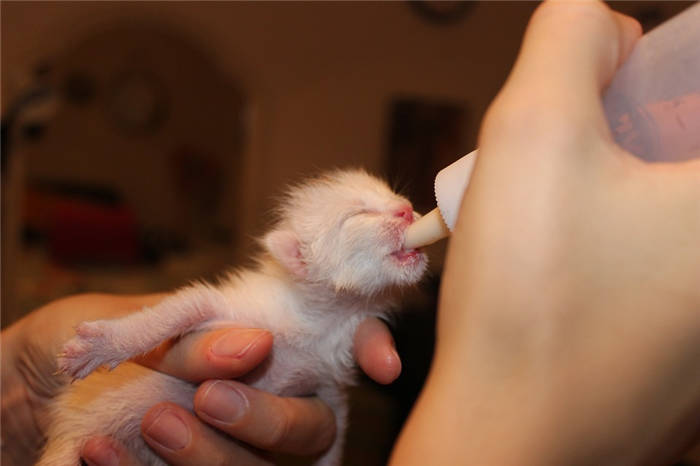
Calculation of the daily portion
In the natural environment, the cat has no control over the amount of milk eaten by the kittens. But since the task is to feed the kitten without a cat – you need to comply with certain norms. The baby is rapidly gaining weight, but the volume of his stomach is very small, so the feeding must be dosed. The daily rate of formula depends on the age of the baby. Below is the amount calculated per 100 grams of body weight of the animal:
These are the recommended figures, they may vary slightly for each breed. The daily volume should be divided by the number of feedings. The most preferable option, as for humans – in small portions, but more often.
Hygiene procedures
In addition to nutrition, you should know other rules of care for a newborn kitten. After a meal you can massage the kitty's tummy clockwise with your fingers, or the area under its tail with a cotton pad soaked in water to help it to empty its bowels.
Cats lick their cubs and try to keep their mouths, eyes, ears, and excretory organs clean. Wipe and wash your cat with warm and wet wipes, wipe him to keep him warm after procedures. Wash completely once a day in warm water.
A kitten needs a place to sleep and play at first. A deep box with a soft bedding will do for starters.
Cover the kitty's place with old diapers or cut-up sheets so that it is easy to wash or throw them away.
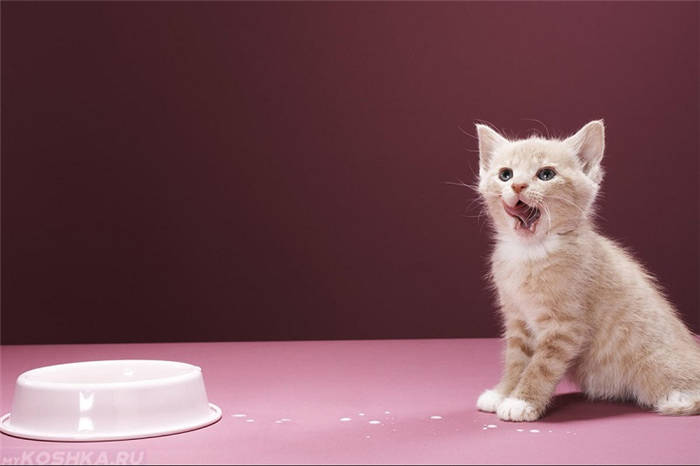
Warming pad for a newborn kitten
The cat keeps her kittens warm, but in her absence, you should put the baby under bottles of warm water, warmers, and cover them with a terry cloth to keep them warm and soft. You can use a lamp that will warm the baby from above.
Ideally the temperature of the place where a newborn kitten is kept should be equal to or slightly above 30 degrees. From the middle of the second week of life the kitten's temperature can be reduced, gradually bringing it to room temperature. During airing the box with the kitten should be taken to another room.
Make sure that the box where the newborn kitten is kept is always warm and dry, and keep it clean. Excessive bacteria from the dirt can be detrimental to the baby's health.
So, we have found that a newborn kitten can be saved and nurtured even in the absence of a cat. It is important to ensure that the pet is fed, clean and cared for. Don't forget to take the cat in your arms, talk to him, pet him, and after a while you will definitely hear a grateful purr in response.
Rules for nursing motherless kittens
If you leave your newborn kittens alone and their mother goes away, gets seriously ill or dies, you need to nurse them yourself. Before this, special equipment should be prepared.
What newborn babies will need
- A source of warmth. Kittens need a special nest temperature. It is maintained at 38 degrees. You can use a special medical electric heating pad or hot water bottles wrapped in a towel. On top of the box, in which there are babies, cover with a warm shawl or plaid.
- Feeding formula. It is better to use special ready-made formula for feeding such babies. They can be purchased at a veterinary pharmacy or an online pet store. Do not use whole cow's milk for this purpose, as it differs significantly from cat's milk in composition and can cause diarrhea in babies.
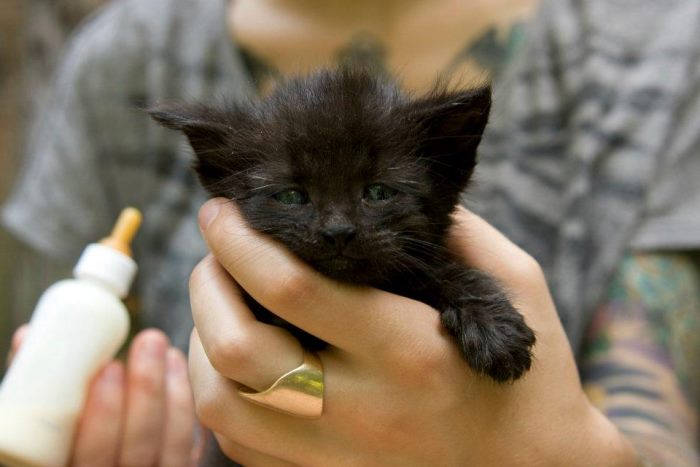
Feeding regimen
- In the first 7 days after birth, babies are fed up to 12 times a day, including at night. These babies are fed formula in an amount of 1.5 tsp.
- By the age of 2 weeks, the feeding regime changes and the number of meals reduced to 6. A 2-week-old kitten eats about 3 teaspoons of formula at a time.
- At 3 weeks, kittens eat 3-4 times a day. The amount of formula consumed at a time -1-2 tbsp. At this age, babies begin to be fed other foods. You can use minced meat or finely chopped lean meat (chicken, turkey, veal, rabbit). Instead of meat, you can give babies soft cottage cheese.
- By 5 weeks, kittens are transferred to three meals a day. At this age, babies eat formula (3-4 tbsp. at a time) and additional complementary foods in the form of meat and sour milk products.
- At 6 weeks, the amount of formula is increased to 5 tablespoons.
Cat milk substitutes and kitten formula
Many cat owners believe that small kittens can be fed only cow's milk, but this opinion is wrong. From such a product the babies will get diarrhea, they will grow badly. As a basic diet for newborn kittens, you should choose special milk substitutes and formula.
The following commercially available cat milk substitutes are available:
- Beaphar (beaphar) Kitty Milk. The product is manufactured in the Netherlands. Dry powder is diluted in warm water in the following proportion: 7 grams of mixture for 50 grams of liquid. The resulting product can be stored in the refrigerator for 8 hours. Before the next feeding it is heated to 40 degrees. The average cost of a milk replacer is 800-1200r. per 200 gr. can.
- Gimpet (Gimpet) Cat-Milk with added taurine. The manufacturer of this product is Germany. The composition of the Gimpet substitute and cat milk are almost identical. The powder is dissolved in hot water in the ratio: 1 tbsp. mixture to 3 tbsp. liquid. The average price of a can of 200 grams is 700-900r.
- Royal Canin (Royal Canin) Babycat Milk. This product is made in France. 10 g of powder dissolved in 20 ml of warm water. The resulting mixture should be fed to babies within 60 minutes. The price of a package weighing 300 grams ranges from 900 to 1300r.
Baby formula for kittens
Baby milk formula for kittens can be used only if it is not possible to buy a full-fledged substitute for cat's milk. When choosing carefully examine the composition of the product: it must be free of sugar.
IMPORTANT: choose formulas designed to feed children from birth, not from 2-3 months of age. Various fruit, honey and other additives that may be included are forbidden for kittens.
Rules for feeding kittens without their mother
Blind kittens are characterized by helplessness and weakness. Providing comfortable living conditions as close to the natural environment as possible is the main task of the owner. This will require following the rules for feeding motherless kittens.
They consist of creating an optimal temperature for the babies in the nest, regular housekeeping, and feeding.
What you will need
A list of what blind kittens will need during this difficult period:
- A food dispenser – a pipette with a small hole will work for blind kittens. This is to prevent food from getting into the airway. For feeding babies who are 10-14 days old, the dropper is changed to a syringe.
- Prepare a cozy, insulated place, equipped for kittens left without a mother to sleep. It is recommended to take a box made of cardboard, cover it with a blanket, put an electric heater or a bottle with warm water under it. The optimal temperature for cubs is 27-30 degrees.
- Arrange a separate area where the feeding will take place. A container of plastic with low sides is suitable for this purpose. On the bottom you need to put a towel or warm cloth. This is necessary in order to prevent the little pets from moving something, clawing at it. In addition, it is allowed to put soft toys.
- Food- The ideal solution would be to find a recently bred cat that can take in another kitten. If this is not possible, special substitutes, baby formula or goat's milk are used instead of cat's milk.
- Additional equipment: gloves, cotton swabs, pieces of gauze, absorbent diapers. It is desirable to purchase scales with which to keep track of growth.
Birth and subsequent growth and development is a difficult period for kittens. If they are left without their mother, they experience even more stress. Therefore, owners are required to provide small pets with everything they need.
Milk substitutes and formula
Milk substitutes and formula made from natural products are used for nursing. This is the only way to make sure that the babies survive. The main thing is that the food in terms of components should match the cat's milk secretion as much as possible.
Among the disadvantages of such food are the lack of proteins, antibodies, beneficial microorganisms that enter the body of newborn cubs with colostrum. These components strengthen the immune system, including by settling the intestine with beneficial microflora.
Important: The offspring left by the cat will only survive if the digestive organs adapt quickly to the substitutes.
Industrial cat milk substitutes
Veterinarians recommend that blind kittens be given commercial cat milk substitutes. The explanation – manufacturers create products taking into account the peculiarities of growth and development of animals.
- Cat-Milk substitute from the brand Gimpet. Advantages: balance of lipids and proteins; natural origin of components; availability of taurine, vitamins, microelements. These factors make the product as close to real milk as possible.
- The product Kitty-Milk from Beaphar. The main advantage is the presence of a full range of trace elements, proteins, vitamins, amino acids. This allows you to meet the needs of the growing body.
- Substitute Babycat Milk from the brand Royal Canin. Pluses: easy digestion, nutrition, completeness of composition. The product contains vitamins, minerals, omega-3, omega-6. Minus – the presence of flavor enhancers, which provoke an allergic reaction.
The method of preparation is the same for each substitute – dissolve a few spoonfuls of mixture in warm water. The amount of product needed is indicated on the instruction label. It is recommended that kittens are given formula until they are 2 months old. If this seems costly, it is advised to switch to baby formula from two weeks of age.
How to feed newborn kittens
Consider the hardest option, how to feed a newborn kitten without a cat. You found and brought home frozen kittens 1-2 hours old. Your next steps are as follows:
- Holding the babies in your arms, boil any milk you can get your hands on.
- Let the milk cool to 36-38 degrees Celsius.
- Put the baby on its stomach in a box with a low rim.Hold the kitten's back and gently press on his cheekbones, opening his mouth.
- Gently put a pacifier in the mouth and press the bottle to squeeze out a drop of milk. If the baby does not suckle, stroke his head and forehead – this is what a cat does, stimulating kittens to more active suckling.
- Feed until the belly is "rounded" and the kitten "falls away" from the pacifier, most often, a full baby falls asleep right away.
- If you didn't have time to buy/make a bottle and use a syringe, practice beforehand! The syringe should not be inserted into the pet's mouth, the kitten may traumatize the gums, your job is to squeeze the milk a drop at a time, letting the baby lick it off. Be careful! With this method of feeding, the kitten takes in a lot of air. After feeding, carry the baby "column" on your shoulder, stroking his back – he will burp air, and then finish feeding the kitten.
After feeding, the babies will need your help. Usually, the mother cat will thoroughly lick the tummy and genital area while feeding. For artificial feeding, you will need a cotton swab or gauze and medical gloves. Soak a tampon in warm water and gently, clockwise massage the kitten's abdomen and genital area, continue until the baby defecates. If the procedure is done after a feeding, the baby should be finished feeding.
Feeding frequency and weight gain
Kittens 0-3 days of age need to eat every 2 hours, regardless of the time of day. Babies' stomachs are tiny and they need a lot of energy, in addition, the process of digestion triggers and stimulates the immune system. From 4 to 14 days of age, babies eat every 4 hours. Keep an eye on the weight of kittens, poor weight gain is an alarming symptom, which means delayed development. Pay more attention to the "laggards", hold the babies in your hands, feed them more often. Average norms for a kitten born with a weight of 90-100 grams:
- 1 week – weight 115-120 g.
- 2 weeks – weight 190-200 grams – feeding 6-7 times a day, including at night.
- 3 week – weight 270-280 grams – stop feeding the baby at night if he sleeps.
- 4 weeks – weight 360-370 grams – feeding 5-6 times a day.
- From 4-5 weeks start introducing complementary foods, the number of feedings is the same.
Consult with your veterinarian or pharmacist vet – the baby needs vitamins, which compensate for the scarce "infant" diet. Of handy remedies you can use:
- Glucose – will help actively gain weight – 1-2 grams per feeding.
- Tetravit, Gamavit – vitamins and immunostimulants – 1 drop per feeding.
- Bone meal – useful for bone and joint formation – 1-2 grams per feeding.
- Fish oil – immune stimulator and source of vitamins, helps with constipation – 1-2 times a week, 1 drop per feeding.
- Vitamin A and D in ampoules – 1 drop per feeding.
As the first complementary food is used grated cottage cheese, diluted with milk. In the beginning, food is licked from the finger, gradually accustomed to eating from a saucer or low bowl. Don't rush to introduce meat products into your diet, it takes a long time for a baby to adapt to new foods.

